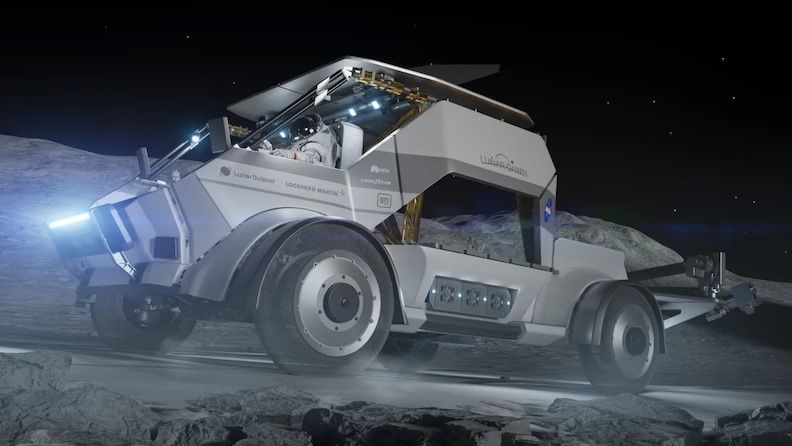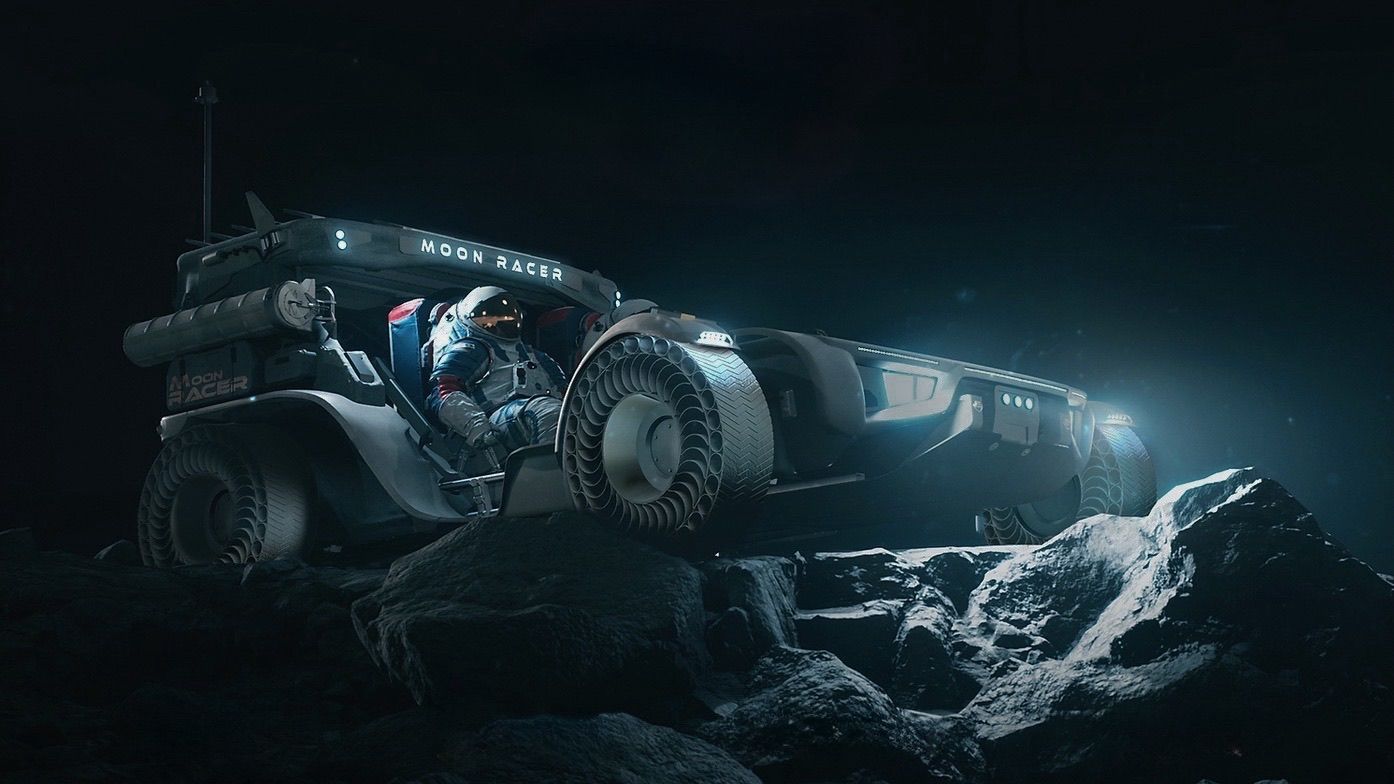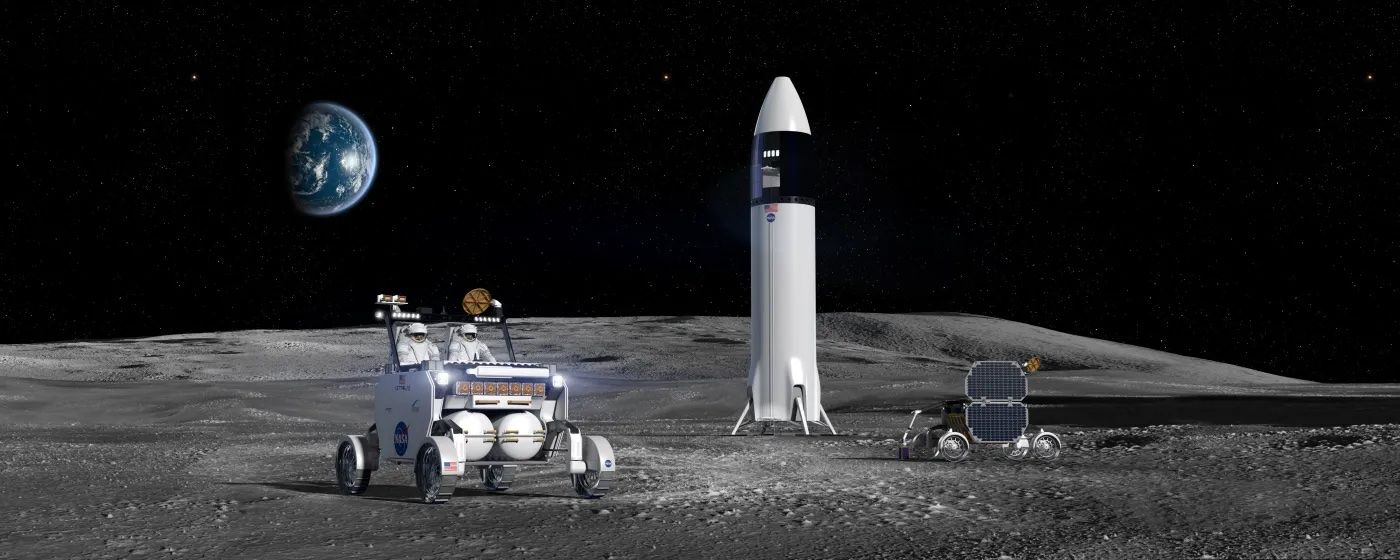NASA Selects Intuitive Machines, Lunar Outpost & Venturi Astrolab to Design a Lunar Terrain Vehicle (LTV) for Artemis Astronauts
(Washington, D.C. & The Moon) The National Aeronautics and Space Administration (NASA) has selected three private teams - led by Intuitive Machines (NASDAQ: LUNR) (which recently became the first private company to accomplish a moon landing), advanced spacecraft and robotics solution company Lunar Outpost and Venturi Astrolab, which is credited with creating the first solar-electric hybrid vehicle - to develop versions of the Lunar Terrain Vehicle (LTV) rover that Artemis astronauts will drive around the moon’s southern polar region beginning in 2030 and take additional steps to advance moon mobility for Artemis missions; the combined maximum potential value of all related NASA LTV-as-a-service awards over the next 13 years is $4.6 billion.

An artist's rendering of NASA's Lunar Terrain Vehicle (LTV), courtesy of NASA.
NASA’s contracts with the three companies will also enable scientific research throughout its Artemis campaign at the Moon and preparation for human missions to Mars, according to a press release from the agency earlier today.
NASA’s Artemis campaign is described by NASA as a campaign to explore the Moon for scientific discovery, technology advancement, and to learn how to live and work on another world as we prepare for human missions to Mars. NASA is collaborating with both commercial and international partners and seeks to establish the first long-term presence on the Moon, according to the agency.
“We look forward to the development of the Artemis generation lunar exploration vehicle to help us advance what we learn at the Moon,” said Vanessa Wyche, director of NASA’s Johnson Space Center in Houston, in the statement released by NASA earlier today. “This vehicle will greatly increase our astronauts’ ability to explore and conduct science on the lunar surface while also serving as a science platform between crewed missions.”
Per today’s release, NASA will acquire the LTV as a service from industry; the indefinite-delivery/indefinite-quantity, milestone-based Lunar Terrain Vehicle Services contract with firm-fixed-price task orders has a combined maximum potential value of $4.6 billion for all awards.

An artist's rendering of Lunar Outpost's Lunar Dawn lunar terrain vehicle, courtesy of NASA.
Each of the selected three teams (from Intuitive Machines, Lunar Outpost and Venturi Astrolab) will develop their rover concepts over the next 12 months under a “feasibility task order” from NASA; thereafter, the teams will be eligible to compete for a different NASA task order - one to build their vehicle and get it on the moon in a key demonstration ahead of the Artemis 5 mission, which is currently scheduled to launch in March of 2030, according to Space.com.
Per Space.com, NASA will buy rover services, rather than the actual LTV[s], in a setup similar to the contracts the agency has signed with SpaceX for cargo and crew delivery services to the International Space Station (ISS), which SpaceX accomplishes with its Falcon 9 rocket and Dragon capsule.
Intuitive Machines announced in its own press release this afternoon that the contract from NASA awards the Intuitive-led team $30 million for the LTV project.
Intuitive Machines’ Reusable Autonomous Crewed Exploration Rover (RACER) team partners include AVL, Boeing (NYSE: BA), Michelin and Northrop Grumman (NYSE: NOC). Together, the groups intend to provide “a robust LTV design architecture with advanced power management, autonomous driving, communications, and navigation systems for lunar exploration,” according to Intuitive Machines’ press release.

An artist's rendering of Intuitive Machines' Lunar Terrain Vehicle (LTV), courtesy of Intuitive Machines.
“This procurement strategically aligns with the Company’s flight-proven capability to deliver payloads to the surface of the Moon under the agency’s Commercial Lunar Payload Services initiative, further solidifying our position as a proven commercial contractor in lunar exploration,” said Intuitive Machines CEO Stephen Altemus. “Our global team is on a path to provide essential lunar infrastructure services to NASA in a project that would allow the Company to retain ownership of the vehicle for commercial utilization during periods of non-NASA activity over approximately ten years of lunar surface activity.”
As for the Lunar Outpost-led team, called the Lunar Dawn team, Lunar Outpost will serve as the prime contractor along with its principal partner Lockheed Martin (NYSE: LMT) and teammates General Motors, The Goodyear Tire & Rubber Company and MDA Space.
“The diverse team combines proven robotic and human space exploration heritage, cutting edge technology and automotive industry strengths to create a true off-road vehicle for living and working on the Moon’s surface,” reads today’s press release from Lunar Outpost.
Per Lunar’s release, the Lunar Dawn LTV will afford Artemis astronauts with an “exceptional experience rooted in safety and convenience,” including a flight-deck forward design providing expansive views for navigating the challenging lunar environment.
“These unique technologies will enable the future of critical infrastructure required for a sustainable presence in space where humans can live, work far from Earth,” said Kirk Shireman, vice president of Lunar Exploration Campaigns at Lockheed Martin. “Lockheed Martin is thrilled to be combining expertise with a diverse set of companies to embark on this next generation rover that will expand exploration and our understanding of the lunar surface.”
Under its newly-announced contract with NASA, Venturi Astrolab, Inc., which is a strategic partner of the Monegasque Venturi Group, will continue to develop its FLEX LTV rover - the first full-scale prototype of which was revealed in March of 2022 - which is equipped with batteries and wheels developed by Gildo Pastor’s teams in Monaco Switzerland, according to today’s press release from Venturi.
Venturi’s teammates include Axiom Space, Inc. and Odyssey Space Research; the company estimates that its NASA contract is worth up to $1.9 billion as part of potential collective task order awards for all three contract winners over the next 13 years, which have a total potential value of $4.6 billion over the life of the program.
Per Venturi Astrolab, as required by NASA, the FLEX LTV can carry two suited astronauts, accommodate a robotic arm to support science exploration, perform robotic cargo logistics, and survive the extreme temperatures at the lunar South Pole, which “is a technological challenge, particularly for the hyper-deformable wheels and batteries.”

An artist's rendering of Venturi Astrolab's FLEX Lunar Terrain Vehicle (LTV) on the Moon, courtesy of Venturi Astrolab.
FLEX can be operated remotely from Earth even when astronauts are not present, or it can be operated by suited astronauts, according to Venturi.
“Astrolab is honored to have its FLEX rover selected by NASA to participate in the development of creating a Lunar Terrain Vehicle for the Artemis Campaign,” said Jaret Matthews, founder & CEO, Astrolab. “Our entire team, together with our business partners, including our strategic partner Venturi Group, are committed to delivering to NASA an LTV that serves as a critical tool in the agency’s efforts to establish a long-term human presence on the Moon.”
Gildo Pastor, President of the Venturi Group, commented: “Through our strategic partnership with Astrolab, I am proud to see the Venturi Group’s know-how validated by NASA. After 20 years of innovation and world records in the field of terrestrial electric vehicles, we are now involved in an adventure that will go down in the history books: when Man returns to the Moon! When I see this rover, equipped with our wheels and batteries, operating up there I will have made my greatest dream come true”.
